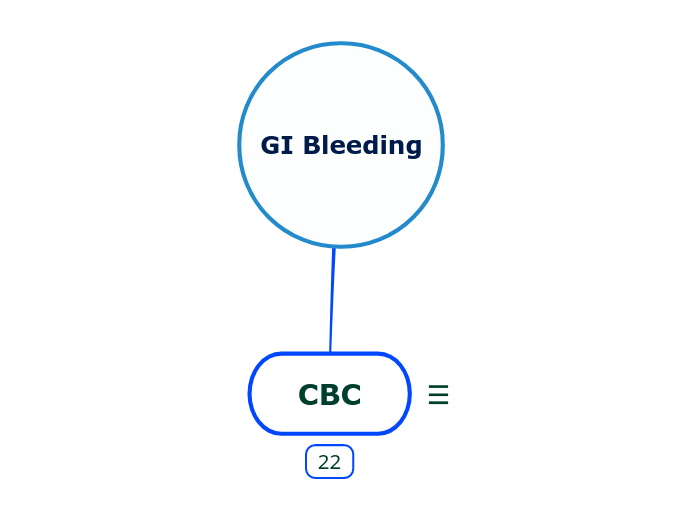GI Bleeding
CBC
- Low Hgb in hemodynamically stable pt slow, chronic bleed
- Normal to mildly decreased Hgb in hemodynamically unstable pt acute, severe bleed
Lower GI
- Below the ligament of Treitz
- More likely older patient
- Occult bleed
- Hematochezia
Anorectal
Painful
- External hemorrhoids below the pectinate line
- Anal tears from straining against hard stool
Painless
Internal hemorrhoids above the pectinate line
Colorectal
Diverticulosis
- Painless hematochezia
- Colonic outpouchings associated with high dietary intake of red meat, low dietary fiber, lack of exercise, being overweight and smoking
Inflammatory Bowel Disease
Ulcerative Colitis
- Continuous colonic involvement beginning distally and extending proximally
- Often presents as bloody diarrhea or hematochezia with abdominal pain
Crohn Disease
- Discontinuous involvement of any part of GI tract; terminal ileum most common
- Often presents as abdominal pain with occult bleeding
Colorectal adenocarcinoma
Sporadic
- Most often left-sided
- Asymptomatic often with occult bleeding (if early, detected by screening) or change in bowel habits +/- hematochezia (if more advanced)
- Iron-deficiency anemia in older male or postmenopausal female is colorectal carcinoma until proven otherwise
- Arise by chromosomal instability pathway with preceding adenoma/dysplasia
- Adenoma features associated with a higher risk for malignant progression include size >1cm, adenomas with villous architecture, presence of high-grade dysplasia, and presence of 3 or more polyps
Familial
- Familial adenomatous polyposis (FAP) syndrome
- Autosomal dominant disorder caused by germline mutations in the tumor suppressor gene APC (adenomatous polyposis coli) with subsequent chromosomal instability pathway similar to sporadic colorectal adenocarcinomas
- Characterized by the presence of 100s to 1000s of adenomatous polyps throughout the colon beginning at a young age
- Most often managed with prophylactic colectomy
- Lynch syndrome (formerly hereditary nonpolyposis colorectal cancer)
- Most common inherited colorectal cancer syndrome
- Autosomal dominant disorder caused by a germline mutation in DNA mismatch repair (MMR) genes that include MLH1, MSH2, MSH6, and PMS2
- Patients inherit one mutant gene; when the second copy is lost through mutation or epigenetic silencing, defects in MMR lead to the accumulation of mutations at rates up to 1000 times higher than normal, mostly in regions containing short repeating sequences referred to as microsatellites (microsatellite instability)
- Carcinomas most often right-sided without a background of numerous adenomas
- Also increases the risk of other cancers, including endometrium, stomach, ovary, ureters, brain, small bowel, hepatobiliary tract, pancreas, and skin.
Upper GI
- Above the ligament of Treitz
- More likely younger patient
- Occult bleed
- Hematemesis
- Melena
Gastric Adenocarcinoma
Intestinal-type
- Multiple genetic and environmental risk factors
- Arises in a background of preceding dysplasia/adenoma
- Appears grossly as an exophytic mass often with large central ulceration
- Histologic exam reveals invading glandular structures within the deeper wall layers (beyond the mucosa)
- p53 mutations common along with several other genetic mutations
Diffuse-type
- Few traditional risk factors
- No known precursors
- Appears grossly as diffuse thickening of the gastric wall (linitis plastica) without a well-defined exophytic mass
- Histologic exam reveals individually invading signet ring cells characterized by a large mucin vacuole that fills the cytoplasm and displaces the nucleus to the side of the cell
- Often associated with loss of e-cadherin expression
Chronic Liver Disease
Portal hypertension in cirrhotic patients leading to esophageal varices
Mechanical Injury
Mallory-Weiss Tears
- Superficial distal esophagus and GEJ mucosa injuries due to sudden increases in intraabdominal pressure
- Often associated with alcoholism or bulimia
Erosive Gastropathy or Gastritis
Loss of protective gastric mucus barrier
Noninfectious
Increased Intracranial Pressure
- Cushing ulcers of the esophagus, stomach, and duodenum due to vagus nerve activation with increased gastric acid secretion
- ICU setting
Severe Burns
- Curling ulcers of the duodenum due to reduced plasma volume leading to mucosal ischemia
- ICU setting
Zollinger Ellison Syndrome
- Rare condition caused by pancreatic or duodenal gastrinomas
- Excessive gastrin secretion leading to parietal cell hyperplasia
- Multiple chronic ulcers that do not respond to therapy
Chemical Irritants (Alcohol)
Direct injury to mucosal cells with impaired mucus secretion
Medications (NSAIDs)
Decreased prostaglandin production due to COX inhibition
Infectious
Helicobacter pylori gastritis
- Most common cause of chronic gastritis, but can also cause acute gastritis
- Gram-negative, curved rod–shaped bacterium with a flagellum, sometimes described as having a “seagull” shape
- Secretes urease leading to inhibition of bicarbonate transporters
- Produces exotoxin vacuolating toxin A (VacA) and mucolytic enzymes that contribute to mucosal damage
- H pylori strains with cytotoxin-associated gene A (CagA) have been shown to be more pathogenic, causing an increased incidence of duodenal ulcers and gastric cancer
- Associated with intestinal-type gastric adenocarcinoma and gastric mucosa-associated lymphoid tissue (MALT) lymphoma

